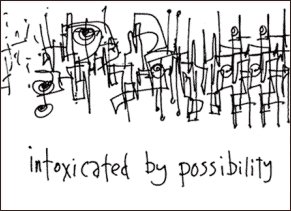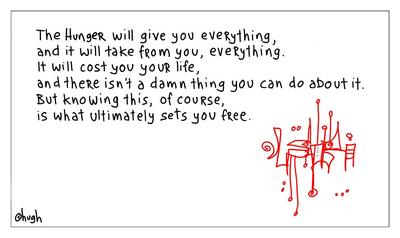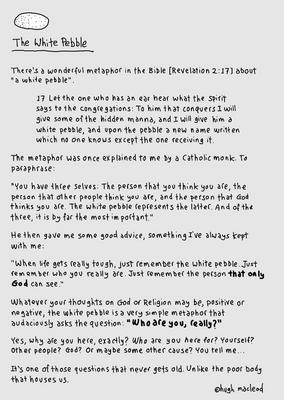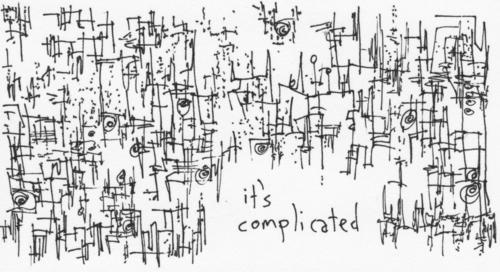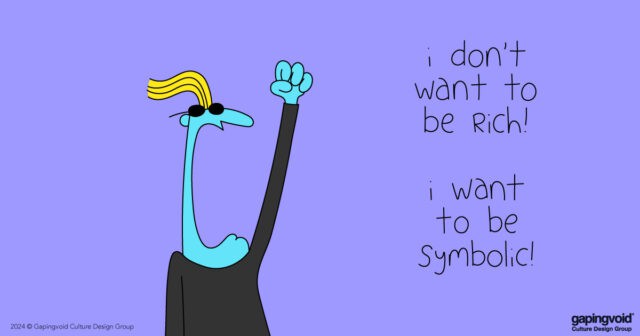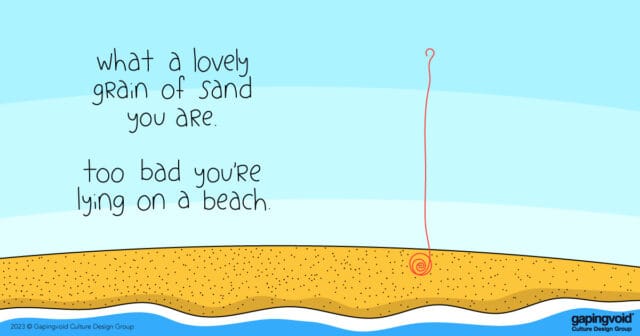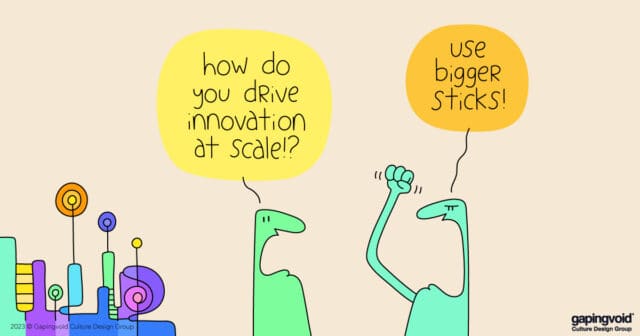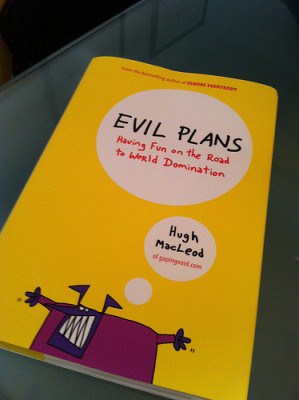
Pre-order the book here:
Amazon.
Barnes & Noble.
Borders.
800-CEO-READ. (great for bulk buys)
[Below is a small taste of the first draft of my upcoming book, “EVIL PLANS”. Published by Penguin/Portfolio, the same people who published my first book, “IGNORE EVERYBODY”. It launchesFebruary 17th, 2011.]
INTRODUCTION: EVERYBODY NEEDS AN EVIL PLAN
Everybody needs an EVIL PLAN. Everybody needs that crazy, out-there idea that allows them to ACTUALLY start doing something they love, doing something that matters. Everybody needs an EVIL PLAN that gets them the hell out of the Rat Race, away from lousy bosses, away from boring, dead-end jobs that they hate. Life is short.
Every person who ever managed to do this, every person who manged to escape the cubical farm and start doing something interesting and meaningful, started off with their own EVIL PLAN. And yeah, pretty much everyone around them- friends, family, colleagues- thought they were nuts.
Thanks to the Internet, it has never been easier to have an EVIL PLAN, to make a great living, doing what you love, doing something that matters. My intention is that by the time you’ve finished reading this book, you will completely concur. More importantly, you’ll actually feel compelled enough to go and do something about it yourself, if you haven’t already.
“TO UNIFY WORK AND LOVE”
Sigmund Freud once said that in order to be truly happy in life, a human being needed to acquire two things: The capacity to work, and the capacity to love.
An EVIL PLAN is really about being able to do both at the same time.
At time of writing, this is my tenth year blogging at gapingvoid.com. I’ve done a lot of stuff with it since I started. Published cartoons, sold wine, sold suits, pimped Microsoft, pimped Dell, sold art, “built my personal brand”, written e-books, ranted on endlessly about marketing, new media and all sorts…
But looking back, I realize it all served a served a common purpose: to unify work and love. I was writing about what interesting and important to me, and trying to turn it into a career somehow.
Then I noticed, the people who read my blog the most avidly, and the bloggers I tend to read most avidly, hell yeah, they’re mostly trying to do the same thing too, in their own way. It’s a definite pattern.
To unify work and love. Are you one of these people? If not, don’t you think you should be? I mean, after friends and family, what the hell is there?
1. THE MARKET FOR SOMETHING TO BELIEVE IN IS INFINITE
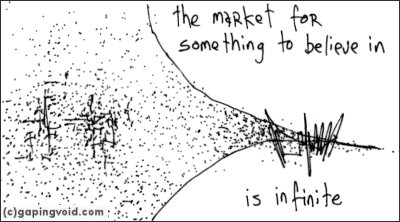
THE HUGHTRAIN MANIFESTO: “THE MARKET FOR SOMETHING TO BELIEVE IN IS INFINITE.”
We are here to find meaning. We are here to help other people do the same. Everything else is secondary.
We humans want to believe in our own species. And we want people, companies and products in our lives that make it easier to do so. That is human nature.
Product benefit doesn’t excite us. Belief in humanity and human potential excites us.
Think less about what your product does, and think more about human potential.
What statement about humanity does your product make?
The bigger the statement, the bigger the idea, the bigger your brand will become.
It’s no longer just enough for people to believe that your product does what it says on the label. They want to believe in you and what you do. And they’ll go elsewhere if they don’t.
It’s not enough for the customer to love your product. They have to love your process as well.
People are not just getting more demanding as consumers, they are getting more demanding as spiritual entities. Branding becomes a spiritual exercise.
Either get with the program or hire a consultant in Extinction Management. No vision, no business. Your life from now on pivots squarely on your vision of human potential.
The primary job of an advertiser is not to communicate benefit, but to communicate conviction.
Benefit is secondary. Benefit is a product of conviction, not vice versa.
Whatever you manufacture, somebody can make it better, faster and cheaper than you.
You do not own the molecules. They are stardust. They belong to God. What you do own is your soul. Nobody can take that away from you. And it is your soul that informs the brand.
It is your soul, and the purpose and beliefs that embodies, that people will buy into.
Ergo, great branding is a spiritual exercise.
Why is your brand great? Why does your brand matter? Seriously. If you don’t know, then nobody else can- no advertiser, no buyer, and certainly no customer.
It’s not about merit. It’s about faith. Belief. Conviction. Courage.
It’s about why you’re on this planet. To make a dent in the universe.
I don’t want to know why your brand is good, or very good, or even great. I want to know why your brand is totally frickin’ amazing.
Once you tell me, I can the world.
And then they will know.
2004 was the year that I drew the cartoon above, which I ended up calling “The Hughtrain”. It appeared in my last book, “Ignore Everybody”, which came out five years later.
Why is it called The Hughtrain? Soon after I drew the cartoon, I wrote a little manifesto on my blog, trying to explain the cartoon in more depth. I called it “The Hughtrain Manifesto”, a pun on a book that had made a big impact on me around that time, “The Cluetrain Manifesto”.
Here’s the point of The Hughtrain: Whatever you’re selling isn’t just a product of capital, it’s also a product of a belief system- your own. And understanding your belief system is crucial. As my friend and mentor, the great marketing author, Seth Godin once told me in an interview I did for him:
You can’t drink any more bottled water than you already do. Or buy more wine. Or more tea. You can’t wear more than one pair of shoes at a time. You can’t get two massages at once…
So, what grows? What do marketers sell that scales?
I’ll tell you what: Belief. Belonging. Mattering. Making a difference. Tribes. We have an unlimited need for this.
Another friend of mine, the film director, David Mackenzie once quipped, “A film is only as good as the reasons for making it”.
What is true for Hollywood, is also true for products and businesses. It’s not what you make, it’s what you believe in. That is what people respond to. That is where your enterprise lives or dies.
The Hughtrain was me trying to articulate my coming to grips with this.
2. WELCOME TO THE HUNGER.
The Hunger to do something creative.
The Hunger to do something amazing.
The Hunger to change the world.
The Hunger to make a difference.
The Hunger to enjoy one’s work.
The Hunger to be able to look back and say, Yeah, cool, I did that.
The Hunger to make the most of this utterly brief blip of time Creation has given us.
The Hunger to dream the good dreams.
The Hunger to have amazing people in our lives.
The Hunger to have the synapses continually fired up on overdrive.
The Hunger to experience beauty.
The Hunger to tell the truth.
The Hunger to be part of something bigger than yourself.
The Hunger to have good stories to tell.
The Hunger to stay the course, despite of the odds.
The Hunger to feel passion.
The Hunger to know and express Love.
The Hunger to know and express Joy.
The Hunger to channel The Divine.
The Hunger to actually feel alive.
The Hunger will give you everything. And it will take from you, everything. It will cost you your life, and there’s not a damn thing you can do about it.
But knowing this, of course, is what ultimately sets you free.
3. THE GLOBAL MICROBRAND.
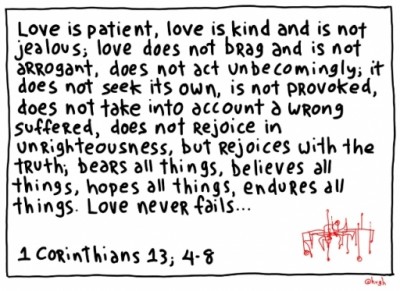
[I first published “The Global Microbrand Rant” on my blog back in 2005. Here it is again:]
Since I first coined the term in 2004, I have been totally besotted with the idea of “The Global Microbrand”.
A small, tiny brand, that “sells” all over the world.
The Global Microbrand is nothing new; they’ve existed for a while, long before the Internet was invented. Imagine a well-known author or painter, selling his work all over the world. Or a small whisky distillery in Scotland. Or a small cheese maker in rural France, whose produce is exported to Paris, London, Tokyo etc. Ditto with a violin maker in Italy. A classical guitar maker in Spain. Or a small English firm making $50,000 shotguns.
With the internet, of course, a Global Microbrand is easier to create than ever before. A commercial sign maker in New England. Or a small sheet metal entrepreneur in the U.K. All using the Internet, blogs, social media and whatnot to spread the word, to talk to people from all over.
And with the advent of blogs in the early years of this Century this was no longer just limited to people who made products. We saw that any service professional with a bit of talent and something to say could spread their message far and wide beyond their immediate client base and local market, without needing a high-profile name or the goodwill of the mainstream media. Lawyers, IT consultants, marketing folk, you name it.
But it’s not just limited to cottage industries. In the 1990’s, the great business guru, Tom Peters talked about “Brand You”, a personal brand that transcends your organization or job description. The grand-daddy of this space is probably Robert Scoble, who worked full-time for Microsoft, but whose brand became much, much larger than any job description they could give him; that’s was worth far more than anything they ever paid him.
Once I created my own fledgling global microbrand (i.e. via my weblog) I started helping other people do the same. A bespoke English tailor. A small winery in South Africa. It was something I really wanted to know about. It was professionally the most compelling idea I had ever come come across. I was hooked.
Of course, “The Global Microbrand” is not conceptual rocket science. You don’t need a Nobel Prize in order to understand the idea. What excites me about it is the fact that I now live in a small adobe in the Far West Texas desert, and careerwise I’m getting a lot more done than when I lived in a large apartment in New York or London, for a fifth of the overheads. For one fiftieth of the stress levels.
My job allows me to travel a lot- New York, Miami, San Francisco etc. After three or four days away I start feeling really stressed out. For years I thought it was just me. No, actually, everyone in the big city seems really stressed out. It’s just considered normal.
I was talking to a friend on the phone about this.
“There’s only two ways to deal with life in the big city,” he says. “Alcohol and high prices. Immersing yourself in high rent, luxury items, trendy, overpriced cocktail bars, flashy restaurants, tall leggy blondes who don’t give a damn about you, just to act as a buffer zone between you and the abyss.”
“Which you pay a lot for,” I say.
“Which you pay a hell of a lot for,” he says.
It seems to me a lot of people of my generation are locked into this high-priced corporate, urban treadmill. Sure, they get paid a lot, but their overheads are also off the scale. The minute they stop tapdancing as fast as they can is the minute they are crushed under the wheels of commerce.
You know what? It’s not sustainable.
However, the Global Microbrand is sustainable. With it you are not beholden to one boss, one company, one customer, one local economy or even one industry. Your brand develops relationships in enough different places to where your permanent address becomes almost irrelavant.
Frankly, it beats the hell out of commuting every morning to the corporate glass box in the big city, something I did for many years. Just so I could make enough money to help me forget that I have to commute every morning to the corporate glass box in the big city.
There are thousands of reasons why people write blogs or spend a lot of time building their online equity. But it seems to me the biggest reason that drives the bloggers I read the most is, we’re all looking for our own personal Global Microbrand. That is the prize. That is the ticket off the corporate treadmill. And I don’t think it’s a bad one to aim for.
4. THE MAGIC NUMBER.
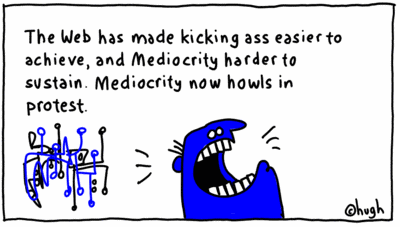
Ten Thousand is my magic number.
The first few years of this century were tough ones for me. My career in advertising pretty much tanked around the same time as the dotcom crash, and I found myself unemployed, broke, living in the boonies, scraping a meagre living writing freelance brochure copy. Then 9–11 came along and made it even worse. Not fun or nice.
Up until that point, I had spent my entire working career “chasing gigs”. Whether we’re talking full-time salaried positions, or three-day freelance opportunities, I had spent well over a decade chasing that ever-elusive island of security in a swelling ocean of advertising-industry chaos. And these gigs would never last, they would always end eventually, for whatever reason. Recessions, layoffs, downsizing, incompetence on my part, incompetence on the boss’ part, whatever. And usually the timing was bad, of course it was.
Chase, chase, chase…. And I was sick of it. Really, REALLY sick of it. Over a decade of working my butt off, and those islands of security were no less elusive than before. And I wasn’t as young as I used to be. The hamster wheel was starting to do me in.
Then, in these darkest of days, I had a sudden flash of life-changing insight. Like I told my fellow burnout-advertising drinking buddy that evening, as we commiserated at the bar about our sad lot in life:
“I don’t want to be chasing gigs anymore.”
“What do you want, then?” asked my buddy.
“I just want ten thousand people giving me money every year.”
“Where are you going to find these people?” he asked.
“The Internet,” I replied.
“What do you plan on doing there?”
“I think I’ll start by publishing my cartoons online… on a blog.”
“What’s a ‘blog’?”
The rest, as they say, is history…
There was nothing magical about the ten thousand number. I just reckoned that, as a cartoonist, if I was making t-shirts, books, whatever– and ten thousand people were buying product every year, with me making a few bucks profit off each unit, well, it wouldn’t make me a billionaire, but at least I’d be able to feed myself.
Also, ten thousand people supporting me seemed like a good way of spreading my bets economically. If one person drops out, and all you lose is a t-shirt sale, with 9,999 other people still on board you can easily recover. But in the world of chasing advertising gigs, if the one person you lose happens to be your jackass boss, you’re dead meat.
There’s nothing special abut the ten thousand number. It all depends on what you’re selling. If you’re selling hand-built motorcycles, your magic number will be less. If you’re selling 5-dollar jars of hot Cajun chilli sauce, your number will be larger. Whatever that number will be, I hope you find it one day. I hope you find THOSE PEOPLE one day.
5. WELCOME TO THE OVER-EXTENDED CLASS.
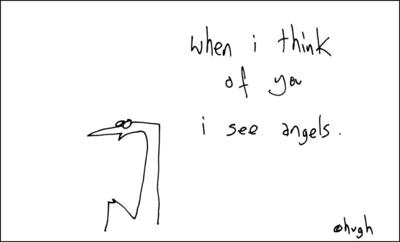
“If ever there was a time to be overextended, this is it.” – Chris Anderson, Editor-In-Chief, Wired Magazine.
Back in August, 2009 I interviewed Chris Anderson for my blog:
Hugh: You’ve got your Editor job, you’ve got your book deals, you’ve got your blog, you do a lot of speaking gigs… As your name gets more and more known, are you having trouble keeping up with everything? What’s your coping mechanism? How do you find the balance?
Chris: Plus the five little kids, the two startup companies on the side, etc. Obviously, balance is a distant goal. In the meantime, I delegate, work all the time, hardly sleep, totally ignore politics, sports and pop culture, neglect my family too much and probably don’t do any ofmy jobs as well as I could. But these are exciting days, and if ever there was a time to be overextended, this is it.
I agree with him completely. I know what it means to be over-extended all too well. Recently I made a list of all the projects I’m currently working on. The next book. The road trip. The prints. Blogging. Consulting. Drawing cartoons. The list goes on…
All in all, it came down to ten items. Ten. Each one interesting and potentially lucrative enough to be taken on as a full-time job. Ten.
Ouch. Even for me, that seemed like WAY too much.
The other day, a friend of mine was kvetching about having to hold down three jobs. “Three?” I quipped. “Try holding down ten…”
My friend looked at me funny. He was probably right to do so.
Since about 1991, it’s been like that for me. From the moment I woke up till the moment I went to bed, I was working on something. The day job or the cartoons or something else. Sure, I’d have girlfriends come and go, but the girlfriends never lasted too long, and I also ended up inventing, in 1997, an art form that would allow me to carry on working WHEN I was going out to the bars i.e. the “cartoons drawn on the back of business cards”.
I’ve not had a proper vacation in ten years, either. Nor am I planning one.
Call Chris and myself, and probably over 50% of the people who are reading this book, members of “The Overextended Class.
You know who you are. And you know what? In terms of percentage of the population, there were less of us twenty years ago. And there’ll be more of us in two decades.
Our parents and grandparents spent their “Cognitive Surplus” watching television. That’s a thing of the past… a historical accident of the old factory-worker age meeting the modern mass-media age. Of course it wouldn’t last forever. We humans as a species were designed to compete, not to sit around on our asses.
Welcome to the Overextended Class, People. You may opt out of it if you want, but over time it’s going to get harder and harder to make ends meet, let alone be successful, if you do.
Choices.
6. A WORLD-CLASS PRODUCT.
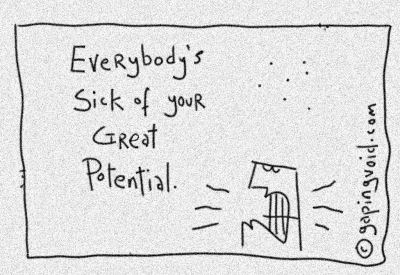
“The curious story of an English Savile Row tailor and an under-employed cartoonist.”
In late 2004, things were still rough for me. I was still broke, unemployed and wondering what the hell I was going to do next. The answer came from a direction I would never have predicted.
At the time, I was living in Cumbria, in a cottage in the Northern English boondocks, not far from the famous Lake District. I was just lying low, scraping a living doing freelance, trying to save money. It was a bleak and miserable time for me, frankly.
In the local village pub, I got friendly with a local fellow named Thomas Mahon. We were about the same age, and his business wasn’t going very well, either.
Thomas was a tailor. He made suits. And not just any kind of suits. He made the best of the best. $5000, hand-made suits. He’d been trained down on Savile Row in London, the legendary English home of tailoring. Some say they make the best suits in the world, there. He had made suits for rock stars, royalty, famous designers and… you name it. He really was that good. The man who trained him, Dennis Halberry, was head cutter for Anderson & Sheppard, one of the most esteemed tailoring firms in the world.
A few years previously, Thomas had got sick of working on Savile Row, decided he missed his beloved Cumbria, and decided to move back home and set up shop in the village he grew up in.
Everyone told him he was mad, but he paid no attention.
Though he was one of the most respected tailors on Savile Row, it turns out he wasn’t very good at getting the word out about his work. His customers loved him, but they didn’t like to tell other people about him. They wanted him all to themselves. So in spite of his formidable talent, Thomas wasn’t getting one-fitth the business he deserved.
So there we were, Christmas approaching, and in spite of us both feeling a wee bit gloomy about our current economic statuses, we were cheerily sitting in the local pub one evening, with Thomas telling me all these wonderful stories about the people and experiences of working on Savile Row.
Finally I interrupted him.
“Tom”, I said, “these Savile Row stories are terrific. You should blog about them.”
“What’s a blog?”
By this time I had been blogging for about three years, and knew all about how it worked. That night, we came up with an EVIL PLAN. I would show Tom how to blog, he would make the suits, I would figure out a way to spread the word online.
EnglishCut.com was born.
Instead of using the blog to hard-sell his suits, Thomas just wrote these great little blog posts about the world he knew and loved- the community of Savile Row tailors. He’d write about it all- his friends on the Row, the pubs they drank in, the other businesses on the Row. He just wrote about it honestly, with great passion and affection. He praised the other shops, his competition. Why not? They were all good people, with second-to-none skills.
A few years later, he would confide in me that he never thought anyone would ever find what he wrote about that interesting, so not expecting anybody to read it, he just wrote it his way. If he had thought a lot of people would be interested in it, he would have written it differently. More uptight. Less transparent.
And boy, was he wrong in the end. People LOVED his blog. They ADORED the transparency and Thomas’ easygoing, unpretentious manner. So much so that, within no time at all, he had gone from under-employed tailor, to having a two-year waiting list, just to get a first appointment.
If you go online and Google Thomas or English Cut, you’ll find a lot to read about. The story got a got of attention in the blogopsphere back then, simply because in 2005, an English Savile Row tailor was probably the person you’d least expect to start a blog. But it worked. It worked AMAZINGLY well.
We worked together for about two more years, before amicably going our separate ways. It was one of the most rewarding career moves I ever made. And I think Thomas would say the same.
My father once remarked to me, “I bet you had no idea in the beginning that the blog would work as well as it did, eh?”
True, I had no idea. But looking back, we had a few things going for us.
i. A great product. Thomas is one of the best tailors in the world. His suits REALLY ARE that good. If we were just selling commodified drek, I doubt if anyone would’ve paid much attention.
ii. A unique story. When he started, Thomas was the only Savile Row tailor writing a blog, and this gave him a unique voice in the blogosphere. This fuelled the interest. Had masses of tailors already been blogging, it would’ve been much harder for his own unique “idea-virus” to spread. The first-mover advantage rule still applies.
iii. Passion & Authority. Thomas has both in spades. That’s what kept people coming back. That’s what built up trust. That’s what turned his readers into customers. Which is why “Share what you love” is the best advice there is.
iv. Continuity. He kept at it. He didn’t expect the blog to transform his fortunes overnight. As I’m fond of saying, “Blogs don’t write themselves”. Based on our experience, if you want blogs to transform your business, I’d say give yourself at least a year.
v. Focus. It was always about the suits. It was never about what he had for breakfast, Google traffic, or frothy gossip about other bloggers.
vi. Thomas spoke in his own voice. Thomas is a straightforward, affable fellow, and the voice on the blog is the same as the voice you meet in real life. He never tried to misrepresent himself on his blog, nor try to create some over-glamorized image of his profession. He just told it like it is. And people responded well to that. As he once put it, “We’re so lucky we don’t have to create the brand out of thin air. We just tell the truth and the brand builds itself.”
vii. Sovereignty. The only people we had to please were the two of us. No bosses or outside investors to keep happy. Bosses and investors like guarantees, but there aren’t any.
viii. We were both broke when we started. Had we had masses of money at the beginning, we would have had a lot more options on how to get the word out. In all likelihood, these options would have been a lot more expensive and not nearly as effective. Sometimes lack of capital is a definite advantage.
A blog is a great way to build one’s own personal “global microbrand”. As the Job-For-Life no longer exists, as the value of the social “position” erodes and the value of the “project” takes its place, personal brand development becomes far more important to one’s career. Blogs are a good place to start.
Hey, if a Savile Row tailor can do it, what’s your excuse?
7. FILL IN THE NARRATIVE GAPS.
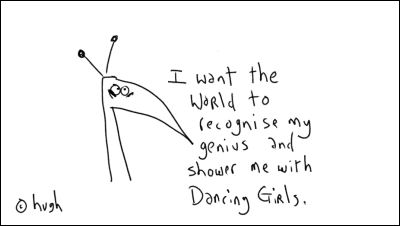
If people like buying your product, it’s because its story helps fill in the narrative gaps in their own lives.
Human beings need to tell stories. Historically, it’s the quickest way we have for transmitting useful information to other members of our species. Stories are not just nice things to have, they are essential survival tools.
And yes, the stories we tell ourselves are just as important than the stories we tell other people.
Ergo, The Global Microbrand is not about selling per se. It’s more about figuring out where your product stands in relation to personal narrative.
So where does your product fit into other people’s narrative? How does telling your story become a survival tool for other people? If you don’t know, you have a marketing problem.
Narrative gaps. It’s all about the narrative gaps.
8. AVOID DINOSAURSPEAK.
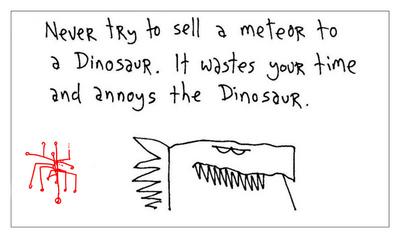
Gapingvoid is the perfect website to get your daily blogging fix. Filled to the brim with hilarious cartoons, it also offers timely and insightful commentary on the new realities of advertising and marketing. Indeed, some people would say it’s just not the blogosphere without gapingvoid to enhance their quality blogging experience. Start your day the switched on way– subscribe to get gapingvoid on your RSS feeder today!
I wrote the preceding paragraph to illustrate the intellectual bankruptcy of what I call “Dinosaurspeak”. That rather sociopathic combination of being completely focused on customer benefit and yet completely selfish at the same time.
And yeah, if it doesn’t work with my shtick, it ain’t going to work with your product, either.
What is interesting to me is that this style of language was pretty universal only a few years ago. Sure, you had a few mavericks out there stirring things up, but most external business communication was pretty much stuck in firehose mode.
But when markets become smarter and faster than the companies servicing said markets, thanks to the Internet, language changes. Of course it does.
So your language you use has be on the cutting edge, or at least, well ahead of the curve. Otherwise you’re just going to sound like everyone else, and people will ignore you.
9. WHO ARE YOU, REALLY?
There’s a wonderful metaphor in the Bible [Revelation 2:17] about “a white pebble”.
“Let the one who has an ear hear what the spirit says to the congregations: To him that conquers I will give some of the hidden manna, and I will give him a white pebble, and upon the pebble a new name written which no one knows except the one receiving it.”
The metaphor was once explained to me by a Catholic monk. To paraphrase:
“You have three selves: The person that you think you are, the person that other people think you are, and the person that God thinks you are. The white pebble represents the latter. And of the three, it is by far the most important.”
He then gave me some good advice, something I’ve always kept with me:
“When life gets really tough, just remember the white pebble. Just remember who you really are. Just remember the person that only God can see.”
Whatever your thoughts on God or Religion may be, positive or negative, the white pebble is a very simple metaphor that audaciously asks the question: “Who are you, really?”
Yes, why are you here, exactly? Who are you here for? Yourself? Other people? God? Or maybe some other cause? You tell me…
It’s one of those questions that never gets old. Unlike the poor body that houses us.
10. THE COMPLEXITY WAR i.e. “SUCCESS IS MORE COMPLEX THAN FAILURE”.
Rudyard Kipling once described Triumph and Disaster as “Impostors, Both”. The longer I stay in the working world, the more I start to get what he means.
It’s funny how you can have two guys sitting next to each other in an office, both doing the same job. Both using the same computers and phones. Both with the same academic qualifications. Both with a similar IQ. Both working the same amount of hours. But why does one guy take home five times more sales commission than the other guy? What’s going on? Is it luck? Skill? Justice? Injustice?
The question of what separates success from failure, is something I’ve always liked to ponder on. Suddenly this week, out of nowhere, the following line hit me:
“Success is more complex than Failure.”
Think about it. Being a failure is a no-brainer. All you have to do is sleep till noon, get out of bed, scratch your crotch, have your morning visit to the bathroom, turn on the Star Trek re-runs, help yourself to some breakfast [Leftover pizza and a bottle of Jack Daniels, Hurrah!], light up your first joint of they day, download some porn, and already you’re well on your way. Sure, a few inconvenient variables may enter the picture here and there, to complicate an otherwise perfect day of FAIL, e.g. what you’re going have to say to your brother in order to convince him to lend you that $300, so you can pay off the telephone bill, that kinda thing. But for the most part, the day-to-day modus operandi of your “Average Total Failure” is quite straightforward.
Being successful, however, is a whole different ball game. Breakfast meetings at 7.00am. Conference calls at midnight. Visiting twelve cities in five days. Fielding question from a swarm of hostile journalists. Dealing successfully with an enraged, multi-million dollar customer who’s screaming bloody murder over something rather trivial in the grand scheme of things. Dealing successfully with an enraged, multi-million dollar investor who’s screaming bloody murder over something rather trivial in the grand scheme of things. Making sure there’s enough money in the account to meet the payroll of all your legions of highly-paid, highly-effective, highly-talented employees. All these hundreds of unrelenting issues to deal with, all day, every day. You get the picture.
And as always, what’s invariably true of people is also invariably true for businesses. So when I see a small but insanely-successful business suddenly implode overnight [it seems to happen quite a lot in Silicon Valley], I’m guessing chances are it wasn’t inability to manage growth per se that destroyed the business [a favorite reason cited by those writing business obituaries], but the inability for the business to manage complexity. Complexity increases exponentially with growth, most small companies can culturally only handle incremental increases in complexity. As I’m fond of saying, “Human beings don’t scale”.
Which is why walking around the hallways of large, successful companies can often seem so oppressive to somebody new to it. All that cultural regimentation is there for one reason only: To fight “The Complexity War”. Sure, it might feel a bit ghastly to the more idealist and free-spirited among us, but until somebody can come up with a better way to win this Complexity War at a Fortune-500 level, I don’t see it ever going away.
11. TREAT IT LIKE AN ADVENTURE. AN ADVENTURE WORTH SHARING.
